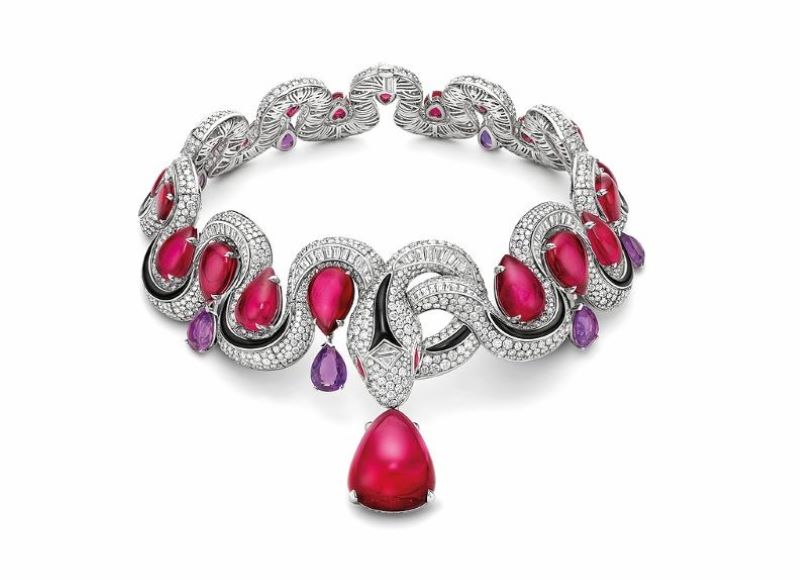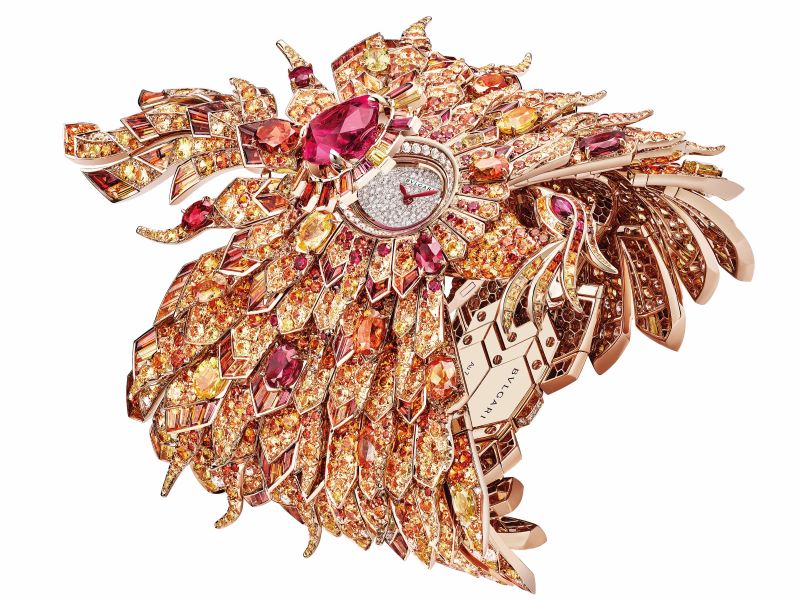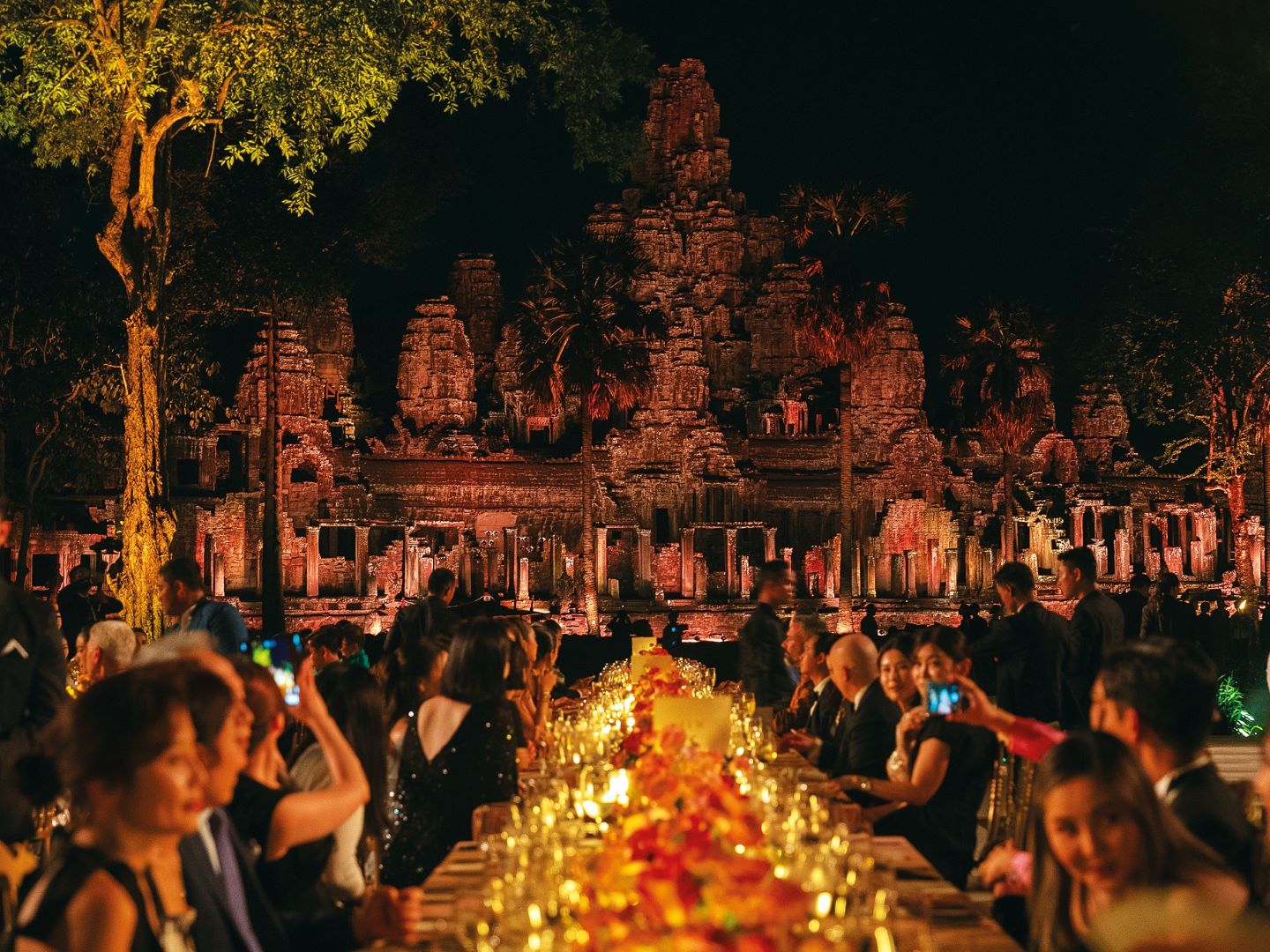
Guests were immersed in an evening of artistry at the gala dinner with Bayon Temple in the background (Photo: Bvlgari)
Right after Christmas in 1859, French naturalist and explorer Alexandre Henri Mouhot, having immersed himself in the charms of Bangkok, ventured into the uncharted territories of Indochina. It took him a year of navigating through terrains tangled with wild vegetation, fending off leopards and leeches, before arriving at the jungle-clad ruins of Angkor nestled deep within Cambodia.
In his diaries containing descriptions and illustrations of Khmer monuments, he wrote, “Amid the province still bearing the name of Ongcor, there is such grandeur that, at the first view, one is filled with profound admiration. What has become of this powerful race — so civilised, so enlightened — the authors of these gigantic works?”
Enraptured by this nexus of poetry, drama and epigraphy, Mouhot (pronounced moo-hoe) was likely describing Angkor Wat — the world’s largest religious structure representing a microcosm of the Hindu universe — when he remarked: “One of these temples, a rival to that of Solomon and erected by some ancient Michelangelo, might take an honourable place beside our most beautiful buildings. It is grander than anything left to us by Greece or Rome.”
Although the Frenchman was mistakenly credited with “rediscovering” Angkor — numerous Western missionaries had seen or known of the hallowed grounds at least 300 years prior — it was his prescient and perceptive observations that captured the imagination of the West and ignited a fervour for archaeological inquiry.
Today, as the sun casts a golden glow upon the elegant spires and elevated honeycomb towers in the city named after the Khmer word nokor, meaning “kingdom”, the same awe that enchanted Mouhot continues to linger. Much like Rome’s fabled relics such as the Colosseum and the Pantheon that have withstood time and turmoil, the Khmer sanctuaries, too, serve as sentinels of a civilisation that shaped the ancient world. With this shared heritage in mind, Bvlgari’s decision to unveil its Aeterna high-end collection, comprising jewellery, watches and bags, in Cambodia’s Temple Town is not merely symbolic but apropos of its mission to bridge the past and present.
Set in stone
The parallel between architecture and artful jewellery lies in their dialogue with time: both reflect the spirit of their era, yet they are envisioned to outlast generations. Embedding itself in locales rich with historical weight and emotional depth has long been Bvlgari’s calling card. For example, the Magnifica collection in 2021 was paraded in Milan’s Galleria Vittorio Emanuele II, accompanied by the operatic talents of Andrea Bocelli and a bevy of supermodels including Vittoria Ceretti and Lily Aldridge. Two years later, shifting from Belle Époque sensibilities to Venetian flair, the maison whisked A-listers Zendaya, Anne Hathaway, Blackpink’s Lisa and Priyanka Chopra to the ornate halls of Palazzo Ducale for its Mediterranea presentation. Hooded dresses may have enjoyed a renaissance thanks to Hathaway’s metallic outfit, but the crowning moment undoubtedly belonged to the six plump pink gemstones encircling her neck.
first_lady.jpg
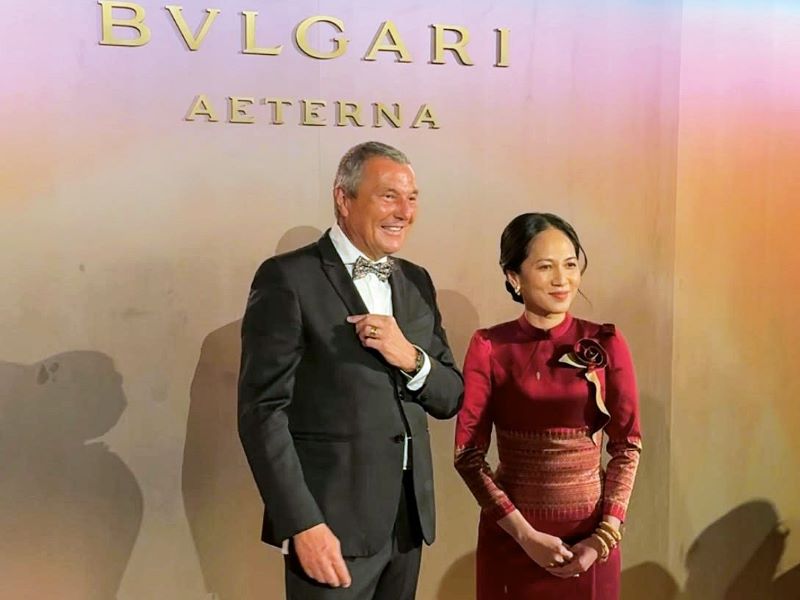
Place and prestige once again played into Bvlgari’s artistic ambition, as the enigmatic Bayon Temple in Angkor Thom served as the backdrop for its Aeterna gala dinner. From afar, Bayon’s silhouette rose like a labyrinth of stone and shadow, its face towers etched with serene depictions that, over time, have been attributed to Brahma, Shiva or Avalokiteśvara, the bodhisattva of mercy. Some also believe them to be portraits of Jayavarman VII, the visionary king who ushered in Angkor’s golden age, watching over his creation through the centuries. As night fell and darkness engulfed the surroundings, light displays heightened the temple’s mystique, illuminating the path to the venue and setting a magical tone for the theatrics ahead.
Brilliance was not confined to the stage alone — seated among the candlelit tables festooned with orange roses and Persian buttercups was a coterie of luminaries shimmering in their own right. Cambodia’s First Lady, Her Excellency Dr Pich Chanmony, was warmly welcomed by Bvlgari CEO Jean-Christophe Babin and jewellery executive creative director Lucia Silvestri. Friends of the House including actress Mai Davika, former Miss Universe and UNAIDS goodwill ambassador Pia Wurtzbach, singer-model Ho Ngoc Ha and actors Mile Phakphum and Ayden Sng — were draped in resplendent Aeterna adornments. The collection’s name, derived from the Latin word “eternal”, underscores themes of immortality and renewal — twin qualities that define both the allure of the Eternal City and the brand’s ever-metamorphosing serpent emblem.
640a9887_1.jpg
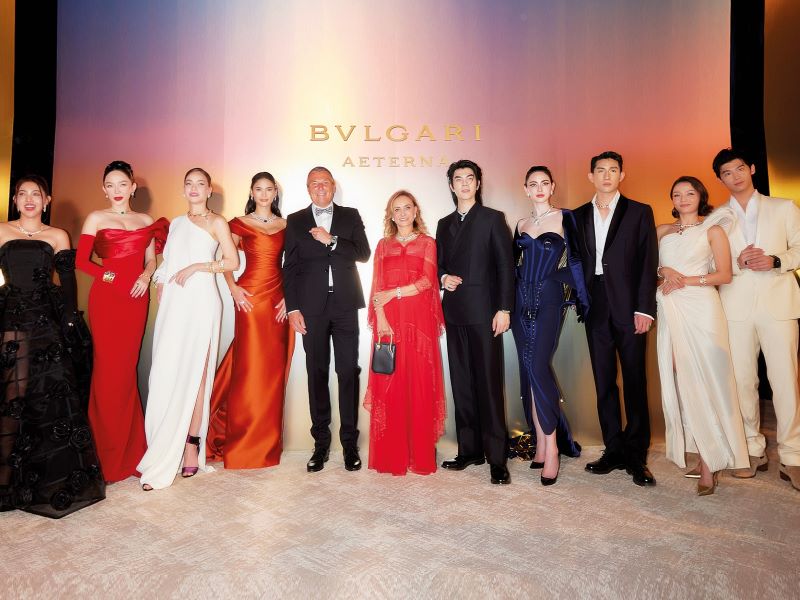
On the runway, each precious marvel became a conduit of luminescence, refracting with every turn, its presence amplified by the drama of movement and music. As models sashayed to the beat of O Fortuna and Romeo and Juliet: Dance of the Knights, colourful beams swept across the Bayon, pulsing in sync with the scores’ crescendos.
The event’s momentum never wavered, even as the three-course dinner — consisting of a steamed lobster appetiser, beef fillet (or barramundi) as well as vanilla-marinated baba dessert filled with mango and passion fruit — was served. The stage transformed once more, this time with Apsara performers entering in gilded silk brocade. A central motif in the stone bas-reliefs of Angkorian temples, the Apsara takes on a new vitality when expressed through dance — its graceful, sinuous motion imbued with symbolism narrating classical myths and religious tales. Poised and deliberate, each tilt and lilt in this centuries-old art form, now enshrined in the Royal Ballet of Cambodia, radiates refinement, emulating the finesse of every Aeterna creation.
bvlgari_yok577_1.jpg
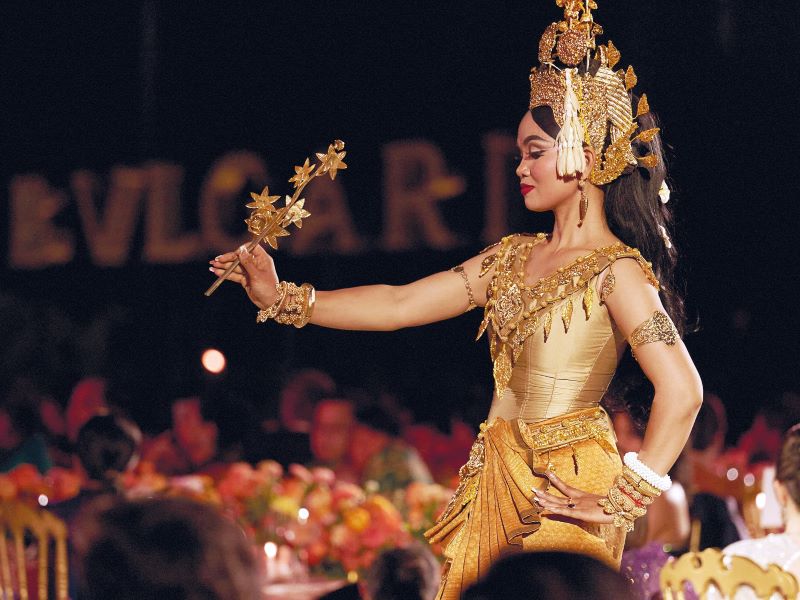
For a company that has made a signature of combining cool and cultural commentary, Bvlgari was not only absorbing the city’s sights but also its sounds. Renowned tenor Khuon Sethisak, Cambodia’s first western opera singer — who performs in Italian, French, Russian, English and Khmer — delivered a stirring rendition of Con te partirò or Time to Say Goodbye in English, popularised by none other than Bocelli. As heartfelt arias met with hearty applause, the sky erupted in a constellation of glittering drones, shape shifting from a star to Bvlgari’s slithering insignia, before spelling out Aeterna. Though not one of crackling sparks, this fireworks of its kind was one of calculated elegance, a closing salvo, that much like the jewellery presented that night, felt timeless and forward-looking.
A star is worn
A piece of Bvlgari does not merely adorn; it declares. Silvestri, who began her journey in the maison’s gemological department at just 18 while studying biology, affirms this. “Our jewels are energy, pressure. They offer emotions not only for the eyes. Suffice to slide one’s fingers along a necklace to know it is Bvlgari. It can be recognised by the cut of the gemstones, the weave of the gold that embraces them — like the pattern of the finest embroidery — revealing the attention to detail of our master artisans.”
Precisely because jewellery is emotional — woven into defining rituals, from marriage and celebration to coronations and battles — its creators must first cultivate a kinship with the materials they shape. Such was the case with the Serpenti Aeterna, monikered “necklace of the 21st century” for featuring seven pear-shaped diamonds totalling 140 carats with D-Flawless clarity.
aeterna.jpg
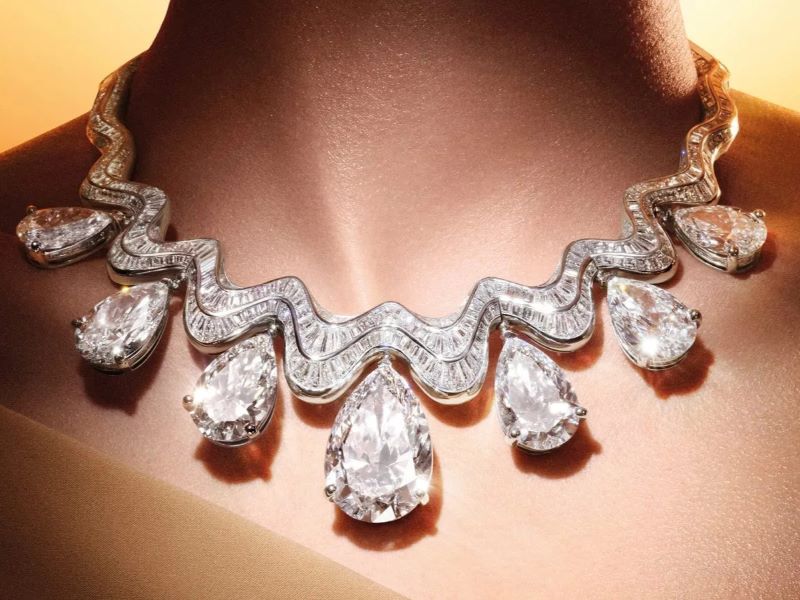
Babin, who became chief executive of the LVMH-owned jeweller in 2013, asserts, “People still see us as a brand that plays with coloured stones even though we have used a lot of diamonds. With the Serpenti Aeterna, we decided to go all the way.” Four years ago, he approved the acquisition of an extremely rare and pure rough 150-carat diamond mined in Lesotho. Attached to a platinum choker set with 698 diamond baguettes and a serpent’s head as the clasp, the final result — which required 2,800 hours from initial design to completion — had 10 carats shaved to coincide with the maison’s 140th anniversary.
“The diamond was something even Lucia had seen only once in her life. The necklace, with its calibrated proportions and nuanced curvature, was sold within half an hour when it debuted in Rome last year. [The client] understood this was a milestone achievement in diamond craftsmanship,” Babin reveals over tea at the Sofitel Angkor Phokeethra Hotel in Siem Reap, though he refrained from identifying the buyer.
This magnum opus, which capped the 156-piece Aeterna collection, may have disappeared from view for now but esteemed guests and VIPs could still revel in the sight of other dazzlers, instilled with a lustre that mirrored the very walls that surrounded them. Blending colonial charm and Khmer vestiges — from the stately archways and teak wood accents to the scenic pond, a glassy expanse broken only by drifting lily pads — Sofitel’s storied past makes for a fitting exhibition space for Bvlgari’s most aspiring ensemble to date.
sofitel.jpg
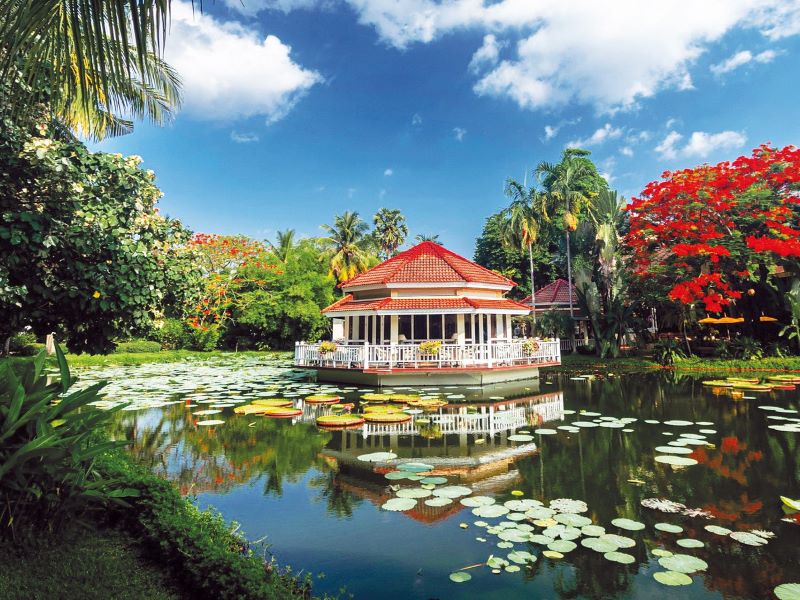
To portray jewellery in a meaningful way is to acknowledge its poetry — the stories it harbours, the personalities it has graced and the gleam that once flitted upon its surface. At the exhibition, each handcrafted treasure was shown in displays inspired by Italian modernist architect Lina Bo Bardi, who famously constructed the new home of Museum of Art São Paulo, perched above a 70m-long square. Rather than positioning the gems against darkened velvet drapes, curators set the scene with reinterpretations of prints by sculptor-architectural theorist Giovanni Battista Piranesi. Suspended from the ceiling, they were rendered on tapestries fashioned from high-density jacquard technique by textile house Rubelli.
Even the platform for mounting the haute joaillerie was not determined arbitrarily. For example, the Fuochi d’artificio High Jewellery Manchette cuff — wrought in rose gold and blue titanium, encircled by a kaleidoscope of coloured stones such as sapphires, mandarin garnets, tanzanites, tsavorites, tourmalines and rubies — was placed on a pedestal with intricate sandstones in the background. These blocks in grey or pinkish hue — designed by master sculptors from Artisans Angkor, a social business established with the aim of providing rural youth with employment while preserving Khmer craftsmanship — were meant to mimic Banteay Srei, or “Citadel of the Woman”. Legend has it that this Angkor temple, commissioned not by a king but a Brahman tutor to Jayavarman V, was built by a woman as the elaborate carvings were supposedly too fine for a man’s hand.
640a8257_1.jpg
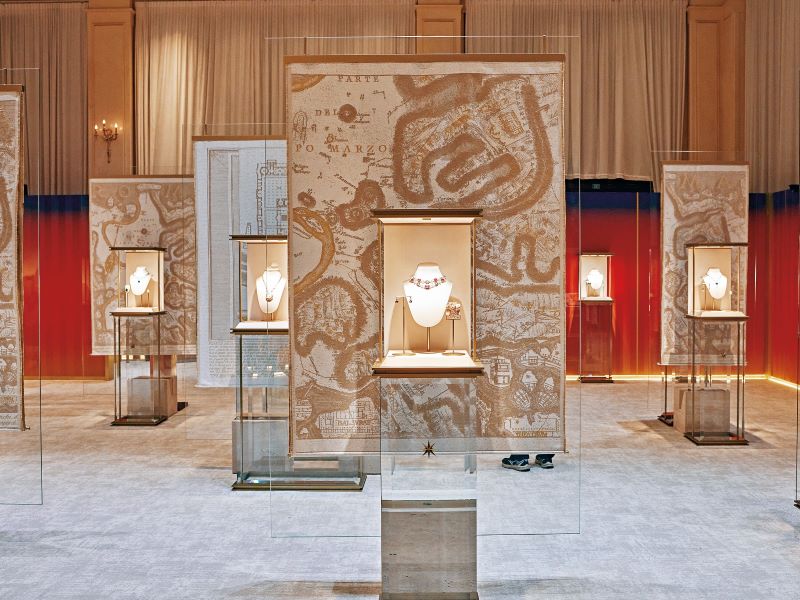
Babin believes that the geographical context in which gems are viewed is as relevant as the frisson of its rarity. “Cambodia is a country I explored as a tourist during my younger days. I’m still fascinated by the Angkor Wat, and it truly deserves its status as a Unesco World Heritage Site. At Bvlgari, we’re constantly surrounding ourselves with art and artists because we want to create something exceptional, since Rome also integrated Egyptian, Persian, Phoenician and Etruscan influences. Having said that, we’re also a brand that perpetually looks forward — it’s the reason I met with [MB&F founder] Maximilian Büsser for our timepiece crossovers, the LM FlyingT Allegra and masculine Serpenti. I’m still amazed by the unlimited creative possibilities of the serpent, which continues to evolve just like shedding new skin.
“In the 140 years we have been making jewellery, we have ensured our offerings can be worn 10, 20 or even 50 years from now. This is not self-glorification because you are wearing art, a slice of history. The appeal of designer shoes only lasts, say, five years, unless they’re worn by a superstar. And if you’re not carrying a luxury bag owned by Jane Birkin herself, it will not be that valuable in the next 20 or 30 years. But diamonds? They will never die. More people are taking interest in high jewellery, even rubies or coloured stones, because in 50 years, we won’t have much left to mine. Their value continues to escalate at auctions, so when you acquire a piece of Bvlgari, you can be certain it will be worth your money in the future.”
Although controlling supply and producing limited editions are crucial to maintain desirability, the captain of the house must also ensure there is enough variety and excitement to entice its youthful and diverse clientele, particularly in the emerging Asian market where high-octane launch events are sought after and sales remain buoyant.
bvlgari_yok223_1.jpg
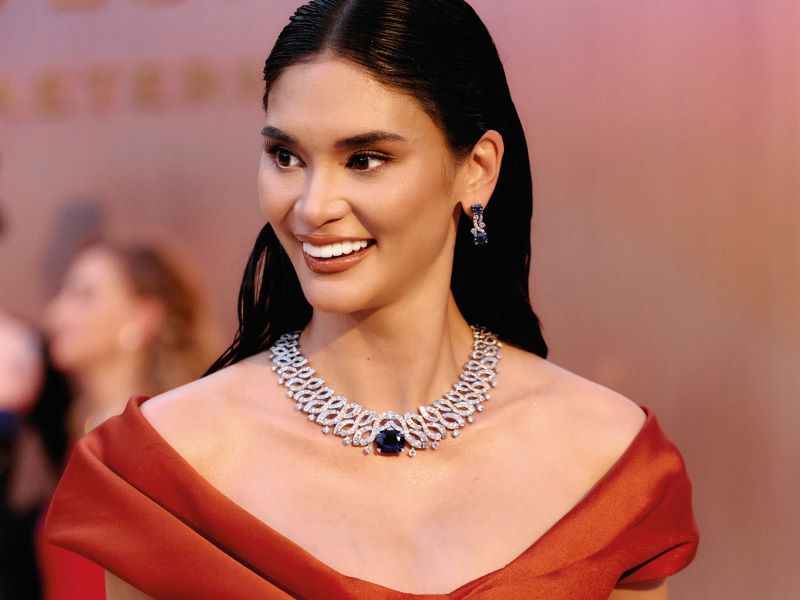
“On a 10-year scale, jewellery is the fastest-growing sector in the luxury world, driven by more women who are attaining gender equality professionally. This means they have the financial independence to indulge themselves without waiting to be gifted. The prevailing sentiment is, sooner or later, people will be more willing to invest in something personal, sophisticated and enduring — goods that will not become obsolete,” says Babin, adding that the number of high jewellery pieces sold is on a positive trajectory.
The Aeterna extravaganza in Cambodia exemplified a wider industry movement to extend exclusivity beyond products and into experiences: storytelling and spectacle, both of which the Italian jeweller has long perfected. Even if you do not speak the country’s language, you only need to know — as Hollywood icon and ardent fan Elizabeth Taylor once professed — Bvlgari.
Gem packed
Highlights from Bvlgari’s paean to eternity
Infinite Chase
Channelling a real-life Princess Diaries moment, Oscar winner Anne Hathaway, who donned the Infinite Chase at the Aeterna collection launch in Rome last year, proved that some jewels are meant for more than just the vault. At the centre lies a 26.54-carat Sri Lankan sapphire cut in an antique cushion shape, emanating a deep blue brilliance. Surrounding it, interlocking diamond figure eights create a dynamic, modular design, featuring 19.94 carats of baguette diamonds and 31.18 carats of pavé-set stones. Crafted in platinum, the necklace rests effortlessly around the neck, balancing fluidity with structural precision.
Serpenti Terra Mater
Inspired by Terra Mater, the ancient Roman personification of the Earth, this piece, which took 2,100 hours to finish, amalgamates the raw beauty of nature and ingenuity of human artistry. You may have spotted Global Brand Ambassador Liu Yifei with the necklace at Bvlgari’s Shanghai launch, flaunting its 63.86-carat cabochon-cut Colombian emerald cradled in the undulating curves of the serpent.
Serpenti Chiselled
First introduced in 1948, the Serpenti has reared its head in countless iterations. However, the Chiselled shifts the focus to an abstract interpretation of its scales instead. Taking cues from Roman sculpture, this avant-garde conversation starter draws attention to the 77.78-carat pear-shaped rubellite in a vivid strawberry-red hue, dangling dramatically from the reptile’s mouth. Nine pear-cut amethysts and 20 cabochon pear rubellites lend depth to its composition, while black onyx inlays add a bold contrast to this wearable art.
Fenice High Jewellery Secret
A legendary creature that rises from its own embers, the phoenix in this secret watch is enveloped by golden spikes that represent the light of resurrection, paying homage to Gian Lorenzo Bernini’s revered altarpiece at Santa Maria della Vittoria. A breathtaking 9.95-carat pear-shaped rubellite emits fiery intensity, ringed by a selection of mandarin garnets, rubies, yellow sapphires, citrines and pyropes. This deliberate arrangement forms a mesmerising dégradé effect that transitions from deep crimson to molten gold, cementing the maison as a virtuoso in manipulating coloured gemstones.
Serpenti Misteriosi Dragone
This physical manifestation of glamour encapsulates Bvlgari’s deep connection to Hollywood’s heyday in the early to mid-20th century. Influenced by the Serpenti timepiece worn by Elizabeth Taylor on the set of Cleopatra at Rome’s Cinecittà Studios in 1962, the Misteriosi Dragone is a respectful ode to its vintage predecessor, sporting a tubolari bracelet resembling the lithe form of a serpent, while its head is ornamented with a striking cluster of baguette-cut diamonds.
This story first appeared on Mar 10, 2025 in The Edge Malaysia.



